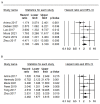The Predicting Role of the Neutrophil-to-Lymphocyte Ratio for the Tumor Grade and Prognosis in Pancreatic Neuroendocrine Tumors
- PMID: 35328291
- PMCID: PMC8947579
- DOI: 10.3390/diagnostics12030737
The Predicting Role of the Neutrophil-to-Lymphocyte Ratio for the Tumor Grade and Prognosis in Pancreatic Neuroendocrine Tumors
Abstract
This study aims to investigate the prognostic role of the neutrophil-to-lymphocyte ratio (NLR) in pancreatic neuroendocrine tumors (PNETs) using meta-analysis. This study evaluates the correlation between the NLR and the prognosis in PNETs from nine eligible studies. In addition, a subgroup analysis based on the tumor grade, treatment, and evaluation criteria, was conducted. The estimated rate of a high NLR was 0.253 (95% confidence interval (CI) 0.198-0.317). The rate of high NLRs was significantly lower in patients with lower tumor grades (G1) than those with higher tumor grades (G2 or G3). In addition, the mean value of the NLR was significantly lower in lower tumor grades than in higher tumor grades. High NLRs were significantly correlated with worse overall and recurrence-free survivals (hazard ratio (HR) 2.180, 95% CI 1.499-3.169 and HR 2.462, 95% CI 1.677-3.615, respectively). In a subgroup analysis, the prognostic implications of the NLR were found in both higher and lower criteria of a high NLR. Taken together, our results show that the NLR could be useful for predicting the tumor grade and the prognosis in PNETs.
Keywords: biomarkers; inflammation mediators; meta-analysis; pancreatic neuroendocrine tumor; prognosis; tumor grade.
Conflict of interest statement
The authors declare no conflict of interest.
Figures
Similar articles
-
Prediction of Pathological Grades of Pancreatic Neuroendocrine Tumors Based on Dynamic Contrast-Enhanced Ultrasound Quantitative Analysis.Diagnostics (Basel). 2023 Jan 9;13(2):238. doi: 10.3390/diagnostics13020238. Diagnostics (Basel). 2023. PMID: 36673048 Free PMC article.
-
Predictive value of preoperative peripheral blood neutrophil/lymphocyte ratio for lymph node metastasis in patients of resectable pancreatic neuroendocrine tumors: a nomogram-based study.World J Surg Oncol. 2017 May 30;15(1):108. doi: 10.1186/s12957-017-1169-5. World J Surg Oncol. 2017. PMID: 28558772 Free PMC article.
-
Neutrophil-lymphocyte ratio predicts survival in pancreatic neuroendocrine tumors.Oncol Lett. 2017 Apr;13(4):2454-2458. doi: 10.3892/ol.2017.5716. Epub 2017 Feb 13. Oncol Lett. 2017. PMID: 28454419 Free PMC article.
-
Prognostic significance of neutrophil to lymphocyte ratio in pancreatic cancer: a meta-analysis.World J Gastroenterol. 2015 Mar 7;21(9):2807-15. doi: 10.3748/wjg.v21.i9.2807. World J Gastroenterol. 2015. PMID: 25759553 Free PMC article. Review.
-
Prognostic and predictive value of neutrophil-to-lymphocyte ratio after curative rectal cancer resection: A systematic review and meta-analysis.Surg Oncol. 2021 Jun;37:101556. doi: 10.1016/j.suronc.2021.101556. Epub 2021 Mar 31. Surg Oncol. 2021. PMID: 33819850
Cited by
-
Endoscopic ultrasonography-based intratumoral and peritumoral machine learning ultrasomics model for predicting the pathological grading of pancreatic neuroendocrine tumors.BMC Med Imaging. 2025 Jan 18;25(1):22. doi: 10.1186/s12880-025-01555-x. BMC Med Imaging. 2025. PMID: 39827128 Free PMC article.
-
Predictive Value of Neutrophil-Lymphocyte Ratio as a Marker in Antiresorptive Agent-Related Osteonecrosis of the Jaw: A Retrospective Analysis.Diagnostics (Basel). 2022 Jul 29;12(8):1836. doi: 10.3390/diagnostics12081836. Diagnostics (Basel). 2022. PMID: 36010185 Free PMC article.
-
Blockade of neutrophil recruitment to tumor sites based on sialic acid-modified nanoplatforms enhances the efficacy of checkpoint blockade immunotherapy.Asian J Pharm Sci. 2023 Mar;18(2):100784. doi: 10.1016/j.ajps.2023.100784. Epub 2023 Feb 23. Asian J Pharm Sci. 2023. PMID: 36968653 Free PMC article.
-
Evaluating the prognostic significance of the pre-treatment neutrophil-to-lymphocyte and monocyte-to-lymphocyte ratios in 177Lu-DOTATATE PRRT treated patients with advanced metastatic neuroendocrine tumors.Endocrine. 2025 Jul;89(1):308-321. doi: 10.1007/s12020-025-04212-z. Epub 2025 Mar 25. Endocrine. 2025. PMID: 40131599 Free PMC article.
-
The association between jaundice and poorly differentiated pancreatic neuroendocrine neoplasms (Ki67 index > 55.0%).BMC Gastroenterol. 2023 Dec 12;23(1):436. doi: 10.1186/s12876-023-03076-9. BMC Gastroenterol. 2023. PMID: 38087239 Free PMC article.
References
-
- Yao J.C., Hassan M., Phan A., Dagohoy C., Leary C., Mares J.E., Abdalla E.K., Fleming J.B., Vauthey J.N., Rashid A., et al. One hundred years after “carcinoid”: Epidemiology of and prognostic factors for neuroendocrine tumors in 35,825 cases in the United States. J. Clin. Oncol. 2008;26:3063–3072. doi: 10.1200/JCO.2007.15.4377. - DOI - PubMed
LinkOut - more resources
Full Text Sources



